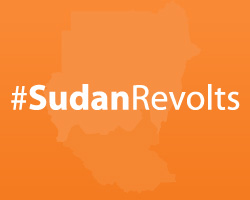
Editor’s Note: This post is intended to provide a contextual background for understanding the complex issues that the Enough Project works on. It is part of the series Enough 101.
On June 16, student-led protests broke out in Sudan’s capital in response to austerity measures announced by President Omar al-Bashir. Since then, waves of anti-regime protests have swept through Sudan, reflecting widespread frustration with the brutality of Bashir’s 23-year-long regime and his failed economic policies. Despite a media crackdown and over 2,000 arrests, protesters continue to take to the streets. This glossary of terms can be used as a guide for understanding the recent demonstrations in Sudan.
Sandstorm Friday
During the first week of protests, most demonstrations were student-led. However, activists urged all Sudanese citizens to mobilize on Friday, June 22, naming the protest “Sandstorm Friday,” a reference to the sandstorms that often take place at this time of year. Fridays are frequently chosen as a day to mobilize because congregational worship and prayers take place on that day. On June 22, hundreds of Sudanese took to the streets after the Friday prayers. The protest movement expanded beyond the university community and gained significant momentum after Sandstorm Friday.
#FreeUsamah
Sudan’s security forces cracked down heavily on journalists and activists following the events of Sandstorm Friday. Usamah Mohamed, a popular social media activist, was arrested on June 22. After his arrest, a massive Twitter campaign was launched to bring attention to the blogger’s detainment, using the hashtag #FreeUsamah. The activist group Girifna reports that Usamah was transferred to Kober prison and may face long-term detainment.
Elbow-Licking
After protesters took to the streets for the second week in a row, Bashir’s top aide, Nafie Ali Nafie, claimed that toppling the regime would be as impossible as licking one’s elbow. Protesters threw this assertion in the regime’s face, when activist groups like Girifna called for mass protests on a day dubbed “Elbow Licking Friday.” On Friday, June 29, hundreds of Sudanese took to the streets bearing posters with slogans like: “We will lick our elbows, Nafie, and yes, it is personal.”
Democratic Alternative Charter
Anti-regime protests have occurred in Sudan before, yet failed to gain much momentum. But analysts say that this recent series of protests may signal the end of Bashir’s rule because, for the first time, opposition parties are presenting a unified front against the Khartoum regime. On July 4, leaders of Sudan’s main opposition parties signed the Democratic Alternative Charter, a roadmap for democratic transition after the fall of the regime. This charter symbolized the unified stance the opposition parties presented against Bashir’s rule.
Kendake Friday
Kendake means “strong women” in the Cushitic language. On July 11, activists announced that they are preparing for a peaceful demonstration on Friday, July 13, dubbed “Kendake Friday.” The protest aimed to honor the role of women in this recent wave of protests and in Sudanese society.
Sudan Revolutionary Front
The Sudan Revolutionary Front, or SRF, is an alliance between rebel groups opposed to President Omar al-Bashir’s government. It is composed of Sudan People’s Liberation Movement-North, the Justice and Equality Movement and the two main factions of the Sudan Liberation Movement/Army. The SRF has thrown its support behind the protesters, calling on all political forces to create a national democratic program. The alliance of rebel groups has also welcomed the Democratic Alternative Charter but noted that more discussions are needed to finalize a comprehensive deal for the post-Bashir regime. The SRF’s support for the protesters indicates to some analysts that this is another sign that Bashir’s rule will end, since, for the first time, a diverse array of opposition groups are rallying to ensure the fall of the regime.
Read other Enough coverage about the protests in Sudan at our #SudanRevolts page.
This post was updated to include the section about the Sudan Revolutionary Front.

